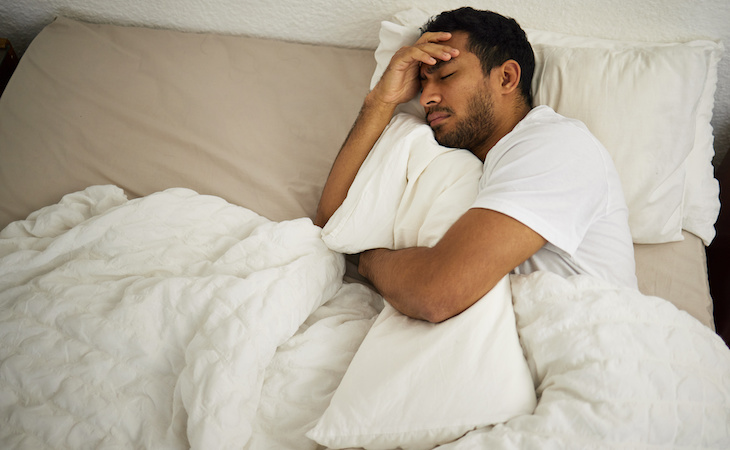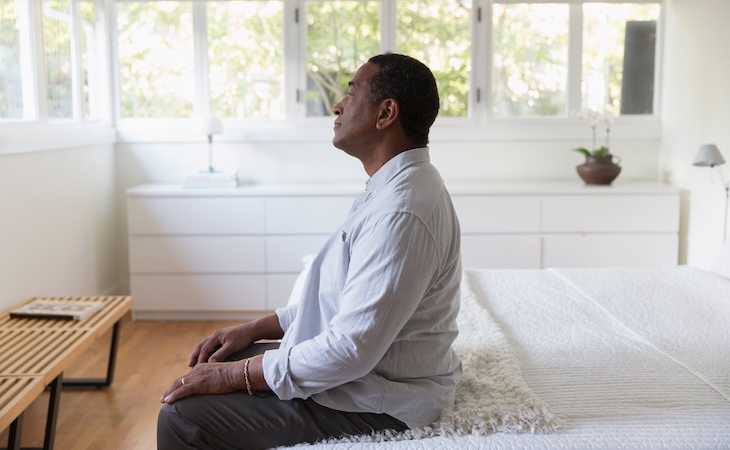The sun rises, ending yet another sleepless night, and you’re left wondering if you’ll ever get the rest you so desperately need.
You’re not alone. More than 30% of individuals in the United States battle with insomnia. Fortunately, various treatment options, such as Cognitive Behavioral Therapy for Insomnia (CBT-I), can help you reclaim sleep.
In this article, we’ll delve into a specific CBT-I method called sleep restriction therapy, a clinically proven technique that can help you get some much-needed rest.
What is sleep restriction therapy—and how does it work?
Sleep restriction therapy was developed by neurologist Arthur Spielman, PhD, to make sleep more efficient. As mentioned, the therapy is one technique that’s used as part of CBT-I and can be a valuable tool in your sleep arsenal when done correctly.
It involves restricting the amount of time you spend in bed awake and is based on the theory that the more time someone with insomnia spends in bed awake, the more they associate their bed with wake time and not with sleep time.
Keep in mind that implementing sleep restriction therapy can be difficult at first because success depends on adhering to a strict sleep schedule. Many individuals may find it challenging to get out of bed at the same time each day despite only getting three or four hours of sleep.
However, adhering to a strict sleep window (the amount of time allotted for sleep) can gradually improve your sleep efficiency. By shortening your sleep window, over time, your mind associates the bed with sleep, and the time you spend in bed actually sleeping gradually increases.
Sleep restriction therapy involves restricting the amount of time you spend in bed awake and is based on the theory that the more time someone with insomnia spends in bed awake, the more they associate their bed with wake time and not with sleep time.
Here’s how you can quickly and easily implement sleep restriction therapy:
- Use a sleep journal or sleep-tracking app to record your sleep patterns for two weeks.
- Use the information to assess the average sleeping hours each night.
- Establish your new bedtime by determining when you need to wake up each day and counting backward to include the total hours spent asleep plus one hour to allow for middle-of-the-night wakings. Experts like Lynelle Schneeberg, PsyD, pediatric sleep psychologist, suggest not restricting the time allotted for sleep to under 5.5 hours. For example, if you average four hours of sleep per night and need to wake up at 6 a.m., then your new bedtime should be 12:30 a.m. So your new sleep window, or time allotted for sleep, is 12:30 a.m. to 6 a.m.
- Stick with your wake time. To continue with our example, you would get out of bed every day at 6 a.m. Resist the temptation to lie in bed past your designated wake time regardless of how tired and sleepy you are. Why? According to Schneeberg, spending more than initially allotted for sleep can backfire as the brain begins to associate the bed with restlessness and anxiety, which can trigger even greater insomnia. “No matter what happens, you still want to get up [at your scheduled wake time], even if you didn’t sleep well,” she says. “Because the next night, you’ll have a lot of sleep debt or sleep drive, and then you will probably sleep better.”
- Stick with your new sleep/wake time schedule for at least two weeks. If you start sleeping through the night, gradually open your sleep window by adding 15 minutes to it each week. Using the above sleep example means a new bedtime of 12:15 a.m.
- Find your ideal bedtime. Over time, if you continue sleeping well through the night and feeling rested throughout the day, then add 15 minutes to your sleep window each week until you hit your ideal bedtime.
The decision as to when to extend your sleep window is based on how much you slept relative to the time you spent in bed. This is called sleep efficiency. Each new extension of time in bed is followed for at least a week before progressing to the next extension.
If the average sleep efficiency is 85% or more, then the time in bed is extended. If it’s below 80%, then the time spent in bed is further restricted unless the restriction shortens the sleep window below 5.5 hours.
Otherwise, the time in bed remains unchanged. There are several variants of this procedure. A sleep therapist can help you further understand and establish a customized CBT-I therapy for your specific sleep challenges.
To get your sleep efficiency number, use this formula:
Total hours sleep each week (÷) number of hours allotted for sleep each week (x) 100
Say you’re sleeping 40 hours per week but allotting 45.5 hours for sleep. Your sleep efficiency score is 87.9%
40 hours (÷) 45.5 hours (x) 100 = 87.9%
Does sleep restriction therapy work?
“[Sleep restriction therapy is] extremely effective because it reassociates your bed with a high sleep efficiency, a rapid sleep onset, and very little waking,” says Schneeberg. Numerous studies like this one also cite sleep restriction therapy as one of the most effective techniques for insomnia.
Anyone who has trouble sleeping should consider sleep restriction therapy. Those with insomnia and anyone who wants to improve their sleep quality should consider this technique.
“[Sleep restriction therapy is] extremely effective because it reassociates your bed with a high sleep efficiency, a rapid sleep onset, and very little waking.”
Lynelle Schneeberg, PsyD, pediatric sleep psychologist
Sleep restriction therapy tips
Use these tips to get the most out of sleep restriction therapy:
- Follow the 20-minute rule. If you wake up during the night and can’t get back to sleep within 20 minutes, then get out of bed and engage in nonstimulating activity until you’re sleepy. Examples include: reading physical books, doing crossword or word search puzzles, knitting, listening to podcasts or audiobooks, etc. Avoid looking at screens to reduce exposure to blue light.
- Don’t spend more time in bed than is necessary. Not sticking to an established sleep window will exacerbate insomnia because you spend extra time in bed not sleeping. Don’t go to bed before your designated bedtime and get out of bed at the end of your sleep window regardless of how tired you are. These tips can help ensure you build a strong sleep drive and are sufficiently sleepy at the start of your sleep window.
- Keep a diary. Schneeberg recommends tracking progress and efficiency by keeping a sleep journal or log. Be sure to record the time you went to bed, the time you got out of bed to start your day, and how much sleep you gained during your sleep window. Use the information to obtain your sleep efficiency ratio, which is the average time spent asleep divided by the time spent in bed.
FAQs
What’s an example of sleep restriction therapy?
Sleep restriction therapy involves limiting the time you spend in bed awake. One way to do this is to follow the 20-minute rule. If you wake up in the middle of the night and can’t fall asleep again within 20 minutes, then get out of bed and do a nonstimulating activity (like reading a physical book) until you’re sleepy.
Is sleep restriction therapy hard?
Sleep restriction therapy can be challenging for some individuals, especially when adhering to a wake time. If you don’t get enough sleep during your sleep window, you may be tempted to lie in bed in an attempt to get more sleep. But, it’s vital for success that you get out of bed when the sleep window ends. That way, the body builds sleep debt during the day that, over time, helps consolidate sleep and improve sleep quality.
Is sleep restriction therapy effective?
According to studies, sleep restriction therapy effectively improves sleep quality among people with insomnia. Sleep restriction therapy is also great for anyone wishing to enhance their sleep quality.
Can I take naps during sleep restriction therapy?
According to Schneeberg, those getting less than five hours of sleep during their sleep window can consider having a rescue nap during the day. “I usually say half an hour to an hour nap after lunch and before 4 p.m. for someone who sleeps at a regular sleep schedule,” says Schneeberg.
Could you have a sleep disorder that’s making it difficult for you to get quality shuteye? Learn about the signs and symptoms of the most common sleep disorders.




